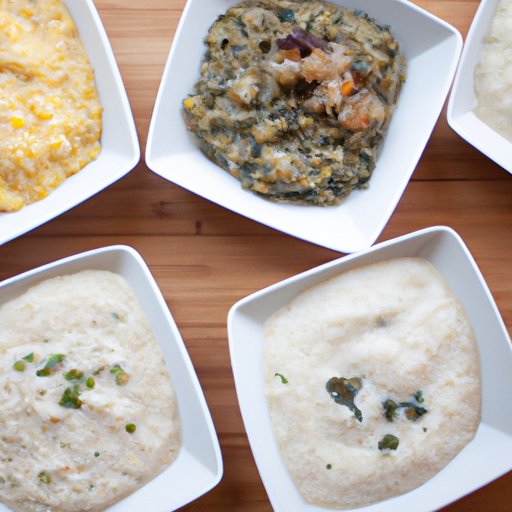Introduction
If you’re like many people, the idea of making grits may seem daunting. The dish is a Southern staple and can be found on menus all across the country, but it can be tricky to get just right. Fortunately, our step-by-step tutorial will show you how to make grits that are creamy, flavorful, and essentially fool-proof. In this article, we’ll cover everything from the basics of what grits are and what you need to make them, to cooking variations, and even a taste test for the perfect finishing touch.
A Step-by-Step Tutorial on Making Grits
Grits are essentially a type of porridge made from finely ground cornmeal, usually served as a breakfast food but can also be enjoyed any time of day. To make grits, you’ll need the following ingredients:
– 1 cup grits
– 4 cups of water or broth
– 1/4 cup heavy cream or butter
– Salt and pepper
Now, let’s dive into the step-by-step process:
1. Bring water or broth to a boil in a medium-sized pot.
2. Add grits, stirring continuously to prevent clumps from forming.
3. Reduce heat to medium-low and let them cook for 20-25 minutes until the grits have absorbed the liquid and become thick.
4. Add heavy cream or butter, stirring until the grits are smooth and creamy.
5. Season with salt and pepper to taste.
Bonus Tip: If you want to spice up your grits with some extra flavor, try adding cheese, bacon, or even shrimp.
Different Ways to Serve Grits
Grits are an incredibly versatile dish that can be served in many different ways. Here are some ideas to get you started:
– Cheese Grits: Add shredded cheese to your grits while stirring in the heavy cream or butter for a rich and decadent flavor.
– Shrimp and Grits: Sauté some fresh shrimp in a pan and add them to your grits for a delicious combination of creamy and savory.
– Grits and Eggs: Top your grits with a fried or scrambled egg for a hearty breakfast or brunch.
– Sweet Grits: Mix in some maple syrup, cinnamon, and a sprinkle of brown sugar for a sweet twist on traditional grits.
The History of Grits
Grits have a long and rich history that dates back to Native American culture. The word “grits” actually comes from the Old English word “grytt,” which referred to a type of porridge made from various grains. Over time, grits evolved into a staple dish in Southern cuisine and became ingrained in American culture. Today, grits are commonly served with other Southern-inspired foods like fried chicken, collard greens, and biscuits.
Cooking Variations for Grits
While the stovetop method is the most common way to cook grits, there are other variations that can make the process even easier. Here are three different ways to try:
– Slow Cooker Grits: Add 4 cups of water and 1 cup of grits to a slow cooker with some salt and butter. Cook on low for 4-5 hours and stir in some heavy cream or cheese for extra creaminess.
– Instant Pot Grits: Add 1 cup of grits, 4 cups of water, and some salt to your Instant Pot. Cook on high pressure for 10 minutes and then manually release the pressure. Stir in some butter or cream and add cheese or bacon for flavor.
– Baked Grits: Mix grits, water, butter, and salt in an oven-safe dish and bake for 45 minutes at 350°F. Serve with your favorite toppings.
A Grits Taste Test
To help you determine the best type of grits for your taste, we conducted a taste test with a group of people. We tried three different types of grits: quick-cooking, stone-ground, and instant. The results showed that while everyone appreciated the speed and convenience of quick-cooking and instant, the stone-ground grits were heartily agreed as the most flavorful and delicious option.
Conclusion
Making grits isn’t as hard as it may seem. With our guide, you can create a delicious bowl of grits that’s sure to impress. Whether you prefer savory or sweet toppings, there are endless possibilities to make grits your own. So don’t be afraid to experiment and find your own perfect recipe – or stick with the classic stone-ground grits to experience Southern comfort food at its finest.
